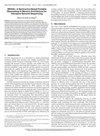真实硬件上的每行激活计数:揭开性能开销的神秘面纱
IF 1.4
3区 计算机科学
Q4 COMPUTER SCIENCE, HARDWARE & ARCHITECTURE
引用次数: 0
摘要
逐行激活计数(PRAC)是一种缓解DRAM读取干扰的方法,它修改了关键的DRAM时序参数,据报道,在基于模拟器的研究中,这会导致显著的性能开销。然而,鉴于模拟器和真实硬件之间的已知差异,真实机实验对于准确估计PRAC性能至关重要。我们首次对PRAC进行了实机性能分析。在使用微基准测试验证最新cpu上的时序修改后,我们的分析表明,在SPEC CPU2017工作负载下,PRAC的平均开销和最大开销仅为1.06%和3.28%,比基于模拟器的报告低9.15倍。此外,我们还表明,关闭页策略通过有效地隐藏由于关键路径上的PRAC而延长的DRAM行预充值操作,从而最大限度地减少了这种开销。本文章由计算机程序翻译,如有差异,请以英文原文为准。
Per-Row Activation Counting on Real Hardware: Demystifying Performance Overheads
Per-Row Activation Counting (PRAC), a DRAM read disturbance mitigation method, modifies key DRAM timing parameters, reportedly causing significant performance overheads in simulator-based studies. However, given known discrepancies between simulators and real hardware, real-machine experiments are vital for accurate PRAC performance estimation. We present the first real-machine performance analysis of PRAC. After verifying timing modifications on the latest CPUs using microbenchmarks, our analysis shows that PRAC’s average and maximum overheads are just 1.06% and 3.28% for the SPEC CPU2017 workloads—up to 9.15× lower than simulator-based reports. Further, we show that the close page policy minimizes this overhead by effectively hiding the elongated DRAM row precharge operations due to PRAC from the critical path.
求助全文
通过发布文献求助,成功后即可免费获取论文全文。
去求助
来源期刊

IEEE Computer Architecture Letters
COMPUTER SCIENCE, HARDWARE & ARCHITECTURE-
CiteScore
4.60
自引率
4.30%
发文量
29
期刊介绍:
IEEE Computer Architecture Letters is a rigorously peer-reviewed forum for publishing early, high-impact results in the areas of uni- and multiprocessor computer systems, computer architecture, microarchitecture, workload characterization, performance evaluation and simulation techniques, and power-aware computing. Submissions are welcomed on any topic in computer architecture, especially but not limited to: microprocessor and multiprocessor systems, microarchitecture and ILP processors, workload characterization, performance evaluation and simulation techniques, compiler-hardware and operating system-hardware interactions, interconnect architectures, memory and cache systems, power and thermal issues at the architecture level, I/O architectures and techniques, independent validation of previously published results, analysis of unsuccessful techniques, domain-specific processor architectures (e.g., embedded, graphics, network, etc.), real-time and high-availability architectures, reconfigurable systems.
 求助内容:
求助内容: 应助结果提醒方式:
应助结果提醒方式:


